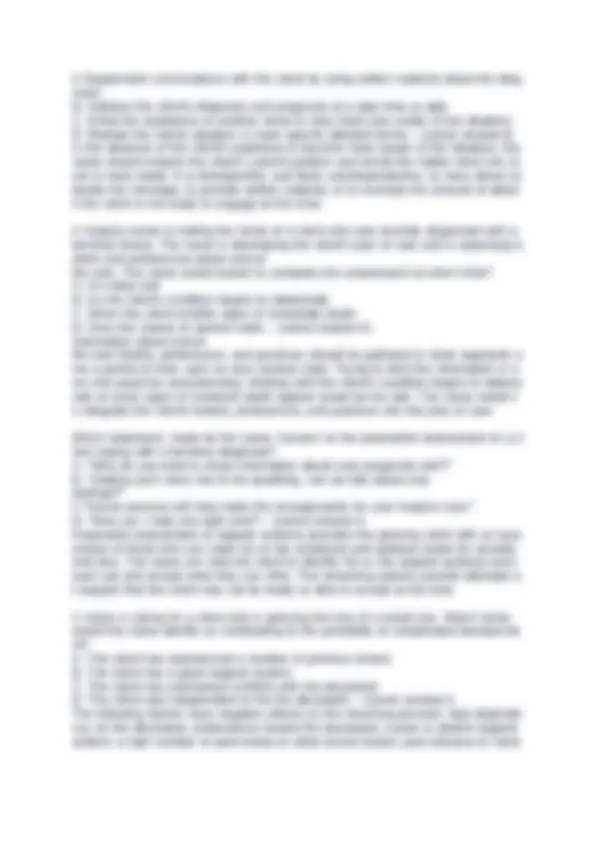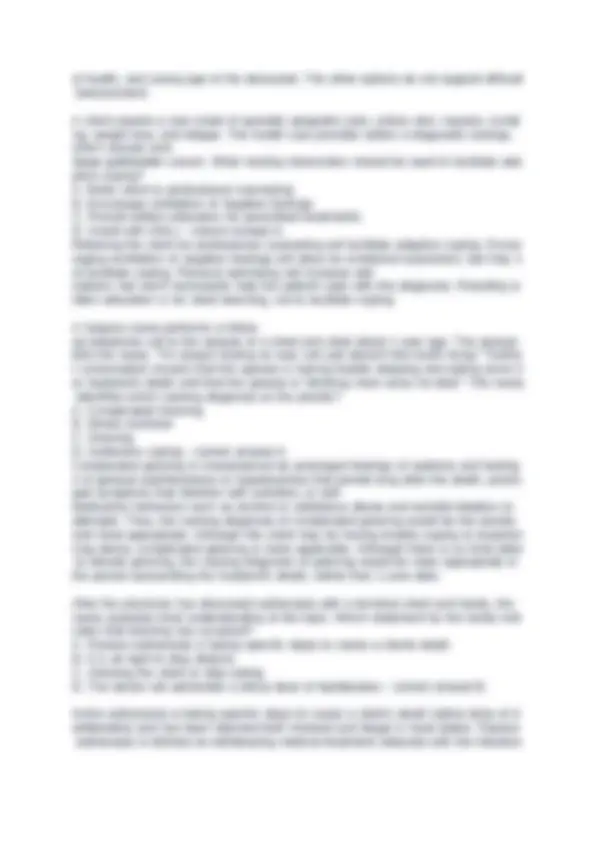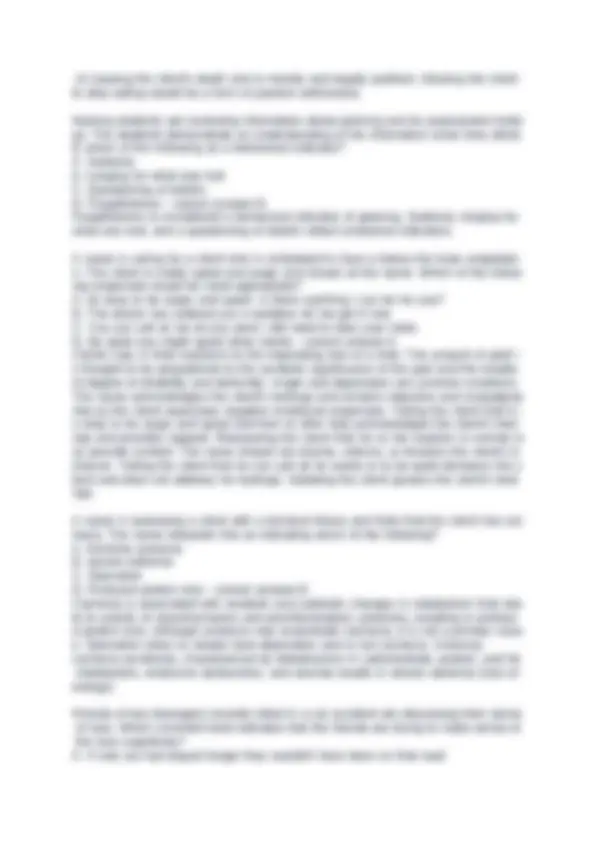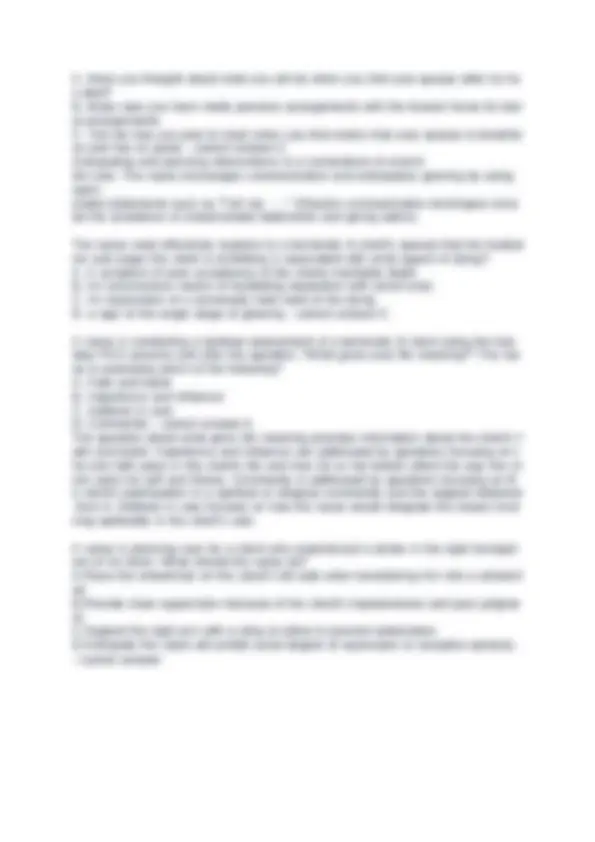






Study with the several resources on Docsity

Earn points by helping other students or get them with a premium plan


Prepare for your exams
Study with the several resources on Docsity

Earn points to download
Earn points by helping other students or get them with a premium plan
Community
Ask the community for help and clear up your study doubts
Discover the best universities in your country according to Docsity users
Free resources
Download our free guides on studying techniques, anxiety management strategies, and thesis advice from Docsity tutors
ADN 420 EXAM 2 PRACTICE QUESTIONS WITH ALL ANSWERS CORRECT.
Typology: Exams
1 / 8

This page cannot be seen from the preview
Don't miss anything!





Thevnursevisvcaringvforvavclientvwhovisvdying.vThevnursevoverhearsvthevclientvsaying, v"God,vifvyouvwillvonlyvletvmevlivevtovseevmyvdaughtervgetvmarried,vIvpromisevIvwillvst artvgoingvtovchurchvagain."vThevnursevunderstandsvthatvthevclientvisvinvwhichvstagev ofvgriefvaccordingvtovKübler-Ross? A.vDepression B.vBargaining C.vAnger D.vDenialv-vcorrectvanswer-B Whenvassessingvavpatientvwhovisvgrieving,vthevnursevidentifiesvseveralvemotionalvin dicators.vWhichvofvthevfollowingvwouldvbevconsistentvwithvthevnurse'svfindings? vSelectvallvthatvapply. 1.vPurposelessvActivity 2.vSelfvBlame 3.vApathy 4.vLackvofvinterest 5.vSocialvwithdrawal 6.vCryingv-vcorrectvanswer-2,3,
Emotionalvindicatorsvofvgrievingvincludevsocialvwithdrawal,vapathy,vandvself- blame.vCrying,vpurposelessvactivity,vandvlackvofvinterestvwouldvbevcategorizedvasvbe havioralvindicators. Avnursevwhovprovidesvcarevonvanvacutevmedicalvunitvhasvobservedvthatvphysiciansv arevfrequentlyvreluctantvtovrefervclientsvtovhospicevcare.vWhatvarevcontributingvfactor svthatvarevknownvtovunderlievthisvtendency?vSelectvallvthatvapply. 1.Financialvpressuresvonvhealthvcarevproviders 2.Clientvreluctancevtovacceptvthisvtypevofvcare 3.Easevofvmakingvavterminalvdiagnosis 4.Advancesvinv"curative"vtreatmentvinvlate-stagevillness 5.Strongvassociationvofvhospicevcarevwithvprolongingvdeathv-vcorrectvanswer-1,2,4v Physiciansvarevreluctantvtovrefervclientsvtovhospice,vandvclientsvarevreluctantvtovacce ptvthisvformvofvcare.vReasonsvincludevthevdifficultiesvinvmakingvavterminalvprognosisv (especiallyvforvthosevclientsvwithvnoncancervdiagnoses),vthevstrongvassociationvofvho spicevwithvdeath,vadvancesvinv"curative"vtreatmentvoptionsvinvlate- stagevillness,vandvfinancialvpressuresvonvhealthvcarevprovidersvthatvmayvcausevthem vtovretainvrathervthanvrefervhospice-eligiblevclients. Whichvofvthevfollowingvwouldvleadvthevnursevtovidentifyvthatvavclientvisvexperiencingv avphysiologicvresponsevtovgrief? A.vCrying B.vChokingvSensation C.vSlowvmovements D.vSadnessv-vcorrectvanswer-B Avchokingvsensationvwouldvbevconsideredvavphysiologicvindicatorvofvgrieving.vSadne ssvwouldvbevanvemotionalvindicator.vSlowvmovementsvandvcryingvwouldvbevconsider edvbehavioralvindicators. Avclientvhasvjustvdiedvfollowingvurosepsisvthatvprogressedvtovsepticvshock.vThevclien t'svspousevsays,v"Ivknewvthisvwasvcoming,vbutvIvfeelvsovnumbvandvhollowvinside."vTh evnursevshouldvknowvthatvthesevstatementsvarevcharacteristicvofvwhat? A.Depressionvstagevofvdying B.Uncomplicatedvgriefvandvmourning C.vAcceptancevstagevofvdying D.vComplicatedvGriefvandvmourningv-vcorrectvanswer-B. Uncomplicatedvgriefvandvmourningvarevcharacterizedvbyvemotionalvfeelingsvofvsadne ss,vanger,vguilt,vandvnumbness;vphysicalvsensations,vsuchvasvhollownessvinvthevsto machvandvtightnessvinvthevchest,vweakness,vandvlackvofvenergy;vcognitionsvthatvincl udevpreoccupationvwithvthevlossvandvavsensevofvthevdeceasedvasvstillvpresent;vandv behaviorsvsuchvasvcrying,vvisitingvplacesvthatvarevremindersvofvthevdeceased,vsocial vwithdrawal,vandvrestlessvoveractivity.vComplicatedvgriefvandvmourningvoccurvatvavpr olongedvtimevaftervthevdeath.vThevspouse'svstatementvdoesvnotvclearlyvsuggestvdepr essionvorvacceptance. Avclientvhasvrespondedvtovthevrecentvdiagnosisvofvlungvcancervbyvmakingvextensivev plansvforvoverseasvtravelvwithvthevclient'svchildren,vdespitevthevfactvthatvthevoncologi stvhasvinformedvthevclientvofvthevextremelyvpoorvprognosis.vThevnursevconsequently vrecognizesvthatvthevclientvisvlikelyvinvthevdenialvstagevofvgrief.vHowvcanvthevnursevb estvfacilitatevadaptivevgrievingvforvthisvclient?
alvhealth,vandvyoungvagevofvthevdeceased.vThevothervoptionsvdovnotvsupportvdifficult vbereavement. Avclientvreportsvavnewvonsetvofvsporadicvepigastricvpain,vyellowvskin,vnausea,vvomiti ng,vweightvloss,vandvfatigue.vThevhealthvcarevprovidervordersvavdiagnosticvworkup,v whichvrevealsvend- stagevgallbladdervcancer.vWhatvnursingvinterventionvshouldvbevusedvtovfacilitatevada ptivevcoping? A.vRefervclientvtovprofessionalvcounseling B.vEncouragevventilationvofvnegativevfeelings C.vProvedvwrittenveducationvforvprescribedvtreatments D.vAssistvwithvADLsv-vcorrectvanswer-A. Referringvthevclientvforvprofessionalvcounselingvwillvfacilitatevadaptivevcoping.vEncou ragingvventilationvofvnegativevfeelingsvwillvallowvforvemotionalvexpression,vbutvmayvn otvfacilitatevcoping.vPhysicalvwell-beingvwillvincreasevself- esteem,vbutvwon'tvnecessarilyvhelpvthevpatientvcopevwithvthevdiagnosis.vProvidingvw rittenveducationvisvforvclientvteaching,vnotvtovfacilitatevcoping. Avhospicevnursevperformsvavfollow- upvtelephonevcallvtovthevspousevofvavclientvwhovdiedvaboutv 1 vyearvago.vThevspousev tellsvthevnurse,v"I'mvalwaysvfeelingvsovsad.vLifevjustvdoesn'tvfeelvworthvliving."vFurthe rvconversationvrevealsvthatvthevspousevisvhavingvtroublevsleepingvandveatingvsincevh ervhusband'svdeathvandvthatvthevspousevisv"drinkingvmorevsincevhevdied."vThevnurse videntifiesvwhichvnursingvdiagnosisvasvthevpriority? A.vComplicatedvGrieving B.vStressvoverload C.vGrieving D.vIneffectivevcopingv-vcorrectvanswer-A.v Complicatedvgrievingvisvcharacterizedvbyvprolongedvfeelingsvofvsadnessvandvfeeling svofvgeneralvworthlessnessvorvhopelessnessvthatvpersistvlongvaftervthevdeath,vprolon gedvsymptomsvthatvinterferevwithvactivities,vorvself- destructivevbehaviorsvsuchvasvalcoholvorvsubstancevabusevandvsuicidalvideationvorv attempts.vThus,vthevnursingvdiagnosisvofvcomplicatedvgrievingvwouldvbevthevpriorityv andvmostvappropriate.vAlthoughvthevclientvmayvbevhavingvtroublevcopingvorvexperien cingvstress,vcomplicatedvgrievingvisvmorevapplicable.vAlthoughvtherevisvnovtimevtable vtovdenotevgrieving,vthevnursingvdiagnosisvofvgrievingvwouldvbevmorevappropriatevinv thevperiodvsurroundingvthevhusband'svdeath,vrathervthanv 1 vyearvlater. Aftervthevphysicianvhasvdiscussedveuthanasiavwithvavterminalvclientvandvfamily,vthev nursevassessesvtheirvunderstandingvofvthevtopic.vWhichvstatementvbyvthevfamilyvindi catesvthatvlearningvhasvoccurred? A.vPassiveveuthanasiavisvtakingvspecificvstepsvtovcausevavclientsvdeath B.vItvisvallvrightvtovstopvdialysis C.vAllowingvthevclientvtovstopveatingv D.vThevdoctorvwillvadministervavlethalvdosevofvbarbituratesv-vcorrectvanswer-B. Activeveuthanasiavisvtakingvspecificvstepsvtovcausevavclient'svdeathv(lethalvdosevofvb arbiturates)vandvhasvbeenvdeemedvbothvimmoralvandvillegalvinvmostvstates.vPassive veuthanasiavisvdefinedvasvwithdrawingvmedicalvtreatmentv(dialysis)vwithvthevintention
vofvcausingvthevclient'svdeathvandvisvmorallyvandvlegallyvjustified.vAllowingvthevclientv tovstopveatingvwouldvbevavformvofvpassiveveuthanasia. Nursingvstudentsvarevreviewingvinformationvaboutvgrievingvandvitsvassessmentvfindin gs.vThevstudentsvdemonstratevanvunderstandingvofvthevinformationvwhenvtheyvidenti fyvwhichvofvthevfollowingvasvavbehavioralvindicator? A.vSadness b.vLongingvforvwhatvwasvlost C.vQuestioningvofvbeliefs D.vForgetfulnessv-vcorrectvanswer-D. Forgetfulnessvisvconsideredvavbehavioralvindicatorvofvgrieving.vSadness,vlongingvforv whatvwasvlost,vandvavquestioningvofvbeliefsvreflectvemotionalvindicators. Avnursevisvcaringvforvavclientvwhovisvscheduledvtovhavevavbelowvthevkneevamputatio n.vThevclientvisvvisiblyvupsetvandvangryvandvshoutsvatvthevnurse.vWhichvofvthevfollow ingvresponsesvwouldvbevmostvappropriate? A.vitsvokayvtovbevangryvandvupset.visvtherevanythingvivcanvdovforvyou? B.vThevdoctorvhasvorderedvyouvavsedativevletvmevgetvitvnow C.vYouvcanvyellvatvmevallvyouvwantvivstillvneedvtovtakevyourvvitals D.vBevquietvyouvmightvupsetvothervclientsv-vcorrectvanswer-A. Clientsvvaryvinvtheirvreactionsvtovthevimpendingvlossvofvavlimb.vThevamountvofvgriefvi svthoughtvtovbevproportionalvtovthevsymbolicvsignificancevofvthevpartvandvthevresulta ntvdegreevofvdisabilityvandvdeformity.vAngervandvdepressionvarevcommonvemotions.v Thevnursevacknowledgesvthevclient'svfeelingsvandvremainsvobjectivevandvnonjudgme ntalvasvthevclientvexpressesvnegativevemotionalvresponses.vTellingvthevclientvthatvitvi svokayvtovbevangryvandvupsetvandvthenvtovoffervhelpvacknowledgesvthevclient'svfeeli ngsvandvprovidesvsupport.vReassuringvthevclientvthatvhisvorvhervreactionvisvnormalvm ayvprovidevcomfort.vThevnursevshouldvnotvshame,vcriticize,vorvtrivializevthevclient'svb ehavior.vTellingvthevclientvthatvhevcanvyellvallvhevwantsvorvtovbevquietvdemeansvthevc lientvandvdoesvnotvaddressvhisvfeelings.vSedatingvthevclientvignoresvthevclient'svfeeli ngs. Avnursevisvassessingvavclientvwithvavterminalvillnessvandvfindsvthatvthevclientvhasvcac hexia.vThevnursevinterpretsvthisvasvindicatingvwhichvofvthevfollowing? A.vExtremevanorexia B.vseverevasthenia C.vStarvation D.vProfoundvproteinvlossv-vcorrectvanswer-D. Cachexiavisvassociatedvwithvanabolicvandvcatabolicvchangesvinvmetabolismvthatvrela tevtovactivityvofvneurohormonesvandvproinflammatoryvcytokines,vresultingvinvprofoun dvproteinvloss.vAlthoughvanorexiavmayvexacerbatevcachexia,vitvisvnotvavprimaryvcaus e.vStarvationvrefersvtovsimplevfoodvdeprivationvandvisvnotvcachexia.vAnorexia- cachexiavsyndrome,vcharacterizedvbyvdisturbancesvinvcarbohydrate,vprotein,vandvfat vmetabolism,vendocrinevdysfunction,vandvanemiavresultsvinvseverevastheniav(lossvofv energy). Friendsvofvtwovteenagersvrecentlyvkilledvinvavcarvaccidentvarevdiscussingvtheirvsense vofvloss.vWhichvcommentvbestvindicatesvthatvthevfriendsvarevtryingvtovmakevsensevof vthevlossvcognitively? A.vIfvonlyvwevhadvstayedvlongervtheyvwouldn'tvhavevbeenvonvthatvroad
orvagitation;vandvcooling,vmottling,vandvcyanosisvofvthevextremitiesvandvdependentva reas. Avpublicvhealthvnursevisvdevelopingvavplanvtovimplementvstrategiesvtovassistvinvlower ingvofvmaternalvandvinfantvmortalityvratesvforvblackvwomenvinvthevUnitedvStates.vWhi chvfactorsvshouldvnotvbevincludedvinvthevplan? A.Therevremainsvavbiasvamongvhealthvcarevprovidersvtowardvblackvwomen. B.Blackvwomenvhavevlimitedvaccessvtovqualityvofvcare. C.Thevsocioeconomicvstatusvofvthevblackvwomenvisvavconsideration. D.Blackvwomenvhavevadequatevobstetricalvinsurancevcoverage.v-vcorrectvanswer-D. ThevmaternalvmortalityvandvmorbidityvratesvforvblackvwomenvinvthevUnitesvStatesvha vevbeenvthreevtovfourvtimesvhighervthanvforvwhitevwomen.vThisvdifferencevinvthevpre gnancy- relatedvmortalityvratiovisvthevlargestvdisparityvinvthevareavofvmaternalvandvchildvhealt h.vResearchersvdovnotventirelyvunderstandvwhatvaccountsvforvthisvdisparity,vbutvsom evsuspectedvcausesvofvthevhighervmaternalvmortalityvratesvforvminorityvwomenvinclu devlowvsocioeconomicvstatus,vlimitedvorvnovinsurancevcoverage,vbiasvamongvhealthv carevproviders,vandvqualityvofvcarevavailablevinvthevcommunity. Thevnursevisvcaringvforvavclientvinvavhospicevfacilityvandvusesvhealingvtouch.vAvfamil yvmembervasksvthevnurse,v"Whatvgoodvisvtouchingvgoingvtovdovwithvcancer?"vWhatvi svthevbestvresponsevbyvthevnurse?vSelectvallvthatvapply. 1.Tovstimulatevwoundvhealing 2.Tovdecreasevpain 3.Tovincreasevanxiety 4.Tovpromotevhealth 5.Tovsupportvend-of-lifev-vcorrectvanswer-1,2,4, Healingvtouchvcanvbevusedvbyvnursesvtovstimulatevwoundvhealing,vdecreasevpain,vpr omotevhealth,vandvsupportvend-of- life.vHealingvtouchvdecreasesvanxiety;vitvdoesvnotvincreasevanxiety. Invassessingvavpostmastectomyvclient,vthevnursevdeterminesvthatvthevclientvisvinvden ial.vThevnursevcanvbestvrespondvby A.Interpretingvthevdenial B.Supportingvthevdenial C.vAcceptingvthevdenial D.vConfrontingvthevdenialv-vcorrectvanswer-C. Whenvavclientvisvfacedvwithvbodyvimagevalterationsvand,vpossibly,vterminalvillnessvan dvdeath,vthevnursevshouldvallowvthevclientvtovexpressvtheirvfeelings.vByvacceptingvth evinitialvdenial,vthevnursevacknowledgesvthevrolevthatvdenialvplaysvinvthevcopingvproc ess.vInterpretingvthevclient'svdenialvandvthenvconfrontingvthevclientvwithvitvwillvincreas evtheirvanxiety,vhindervthevdevelopmentvofvavtrustingvrelationship,vandvdelayvthevclie nt'svacceptancevofvtheirvcondition.vAcceptingvthevclient'svdenialvdoesn'tvimplyvthatvth evnursevsupportsvit. Duringvavhomevcarevvisitvtovavclientvinvhospice,vthevclient'svspousevrevealsvtovthevnu rsevanvunderstandingvthatvthevclient'svdeathvisvinevitable.vRecognizingvthevspousevis vexemplifyingvthevKübler- Rossvstagevofvacceptance,vwhichvstatementvbyvthevnursevisvmostvappropriate?
A.vHavevyouvthoughtvaboutvwhatvyouvwillvdovwhenvyouvfindvyourvspousevaftervhevha svdied? B.vMakevsurevyouvhavevmadevpreviousvarrangementsvwithvthevfuneralvhomevforvburi alvarrangements C.vTellvmevhowvyouvplanvtovreactvwhenvyouvfirstvrealizevthatvyourvspousevisvbreathle ssvandvhasvnovpulsev-vcorrectvanswer-C. Anticipatingvandvplanningvinterventionsvisvavcornerstonevofvend-of- lifevcare.vThevnursevencouragesvcommunicationvandvanticipatoryvgrievingvbyvusingv open- endedvstatementsvsuchvasv"Tellvme.v.v.v."vEffectivevcommunicationvtechniquesvinclu devthevavoidancevofvclosed-endedvstatementsvandvgivingvadvice. Thevnursevmostveffectivelyvexplainsvtovavterminallyvillvclient'svspousevthatvthevfrustrat ionvandvangervthevclientvisvexhibitingvisvassociatedvwithvwhatvaspectvofvdying? A.vAvsymptomvofvpoorvacceptancevofvthevclientsvinevitablevdeath B.vAnvunconsciousvmeansvofvfacilitatingvseparationvwithvlovedvones C.vAnvexpressionvofvavuniversallyvheldvneedvofvthevdying D.vavsignvofvthevangervstagevofvgrievingv-vcorrectvanswer-C. Avnursevisvconductingvavspiritualvassessmentvofvavterminallyvillvclientvusingvthevfourv stepvFICAvprocessvandvasksvthevquestion,v"Whatvgivesvyourvlifevmeaning?"vThevnur sevisvassessingvwhichvofvthevfollowing? A.vFaithvandvbelief B.vImportancevandvinfluence C.vAddressvinvcare D.vCommunityv-vcorrectvanswer-A. Thevquestionvaboutvwhatvgivesvlifevmeaningvprovidesvinformationvaboutvthevclient'svf aithvandvbelief.vImportancevandvinfluencevarevaddressedvbyvquestionsvfocusingvonvt hevrolevfaithvplaysvinvthevclient'svlifevandvhowvhisvorvhervbeliefsvaffectvthevwayvthevcli entvcaresvforvselfvandvillness.vCommunityvisvaddressedvbyvquestionsvfocusingvonvth evclient'svparticipationvinvavspiritualvorvreligiousvcommunityvandvthevsupportvobtained vfromvit.vAddressvinvcarevfocusesvonvhowvthevnursevwouldvintegratevthevissuesvinvol vingvspiritualityvinvthevclient'svcare. Avnursevisvplanningvcarevforvavclientvwhovexperiencedvavstrokevinvthevrightvhemisph erevofvhisvbrain.vWhatvshouldvthevnursevdo? A.Placevthevwheelchairvonvthevclient'svleftvsidevwhenvtransferringvhimvintovavwheelch air. B.Providevclosevsupervisionvbecausevofvthevclient'svimpulsivenessvandvpoorvjudgme nt. C.Supportvthevrightvarmvwithvavslingvorvpillowvtovpreventvsubluxation. D.Anticipatevthevclientvwillvexhibitvsomevdegreevofvexpressivevorvreceptivevaphasia.v